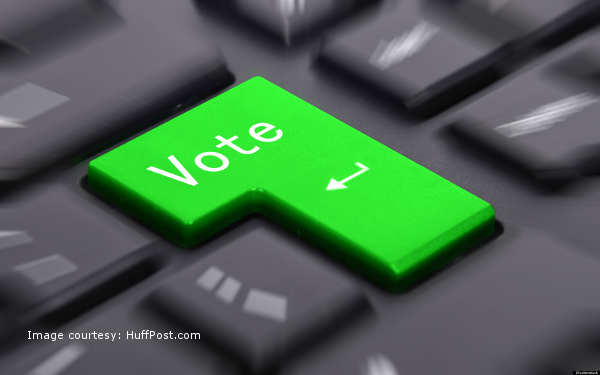Chief Election Commissioner Shri H.S. Brahma has said that in future elections in India, voting by Internet could be a possibility. He further said that the first step in this direction is the plan of the Election Commission to make electoral rolls “totally error free”. However, he refused to fix a specific timeframe for it (see here).

Voting by Internet can be very useful to drastically lift the voting percentage in Indian elections, where national polling percentage is usually low. For example, during the 2014 Lok Sabha elections, the national polling percent was 66.4% which in fact is reported to be highest so far in the history of Indian elections (the previous best polling percentage was in 1984 Lok Sabha elections, when the polling percent was 64%). During 2009 Lok Sabha elections, the voter turnout percentage was only about 58.19%. During the 2014 Lok Sabha elections, out of the total electorate of 83.41 crore, about 55.38 crore voters exercised their voting rights, which means a large number of about 28 crore voters did not cast their votes.
Now, 28 crore voters not casting their votes in a general elections, which decide the fate of the country, is a very large number indeed. It is generally experienced that higher echelons of the society, comprising rich and middle class people generally do not come out in large numbers on election days to cast their votes, while poor people are usually more responsible in this regard.
The number of Internet users in India is expected to have crossed 30 crores at the end of 2014. And, this number is increasing very fast, more so, with the Digital India plan of the Government and with the Government planning to connect 2.5 lakh Gram Panchayats (villages) with broadband Internet through the National Optical Fiber Network (NOFN) project by the end of the year 2016. Similarly, as per the latest estimates, the number of mobile phones in India is about 97 crores, which means about 78% penetration considering that the population of India is about 126 crore.
Voting by Internet gives you the convenience of voting from home or from wherever you are. You can vote from any part of the world and it is not necessary that you must be at the place (city or village) where you are registered for your vote and equally it is not necessary that you must visit the specified polling booth for casting your vote. You can use your ubiquitous smartphone to vote at the general elections. This can drastically increase the voting percentages, thereby making the democracy more real.
Of course, there are doubts about security, integrity, privacy, authenticity, manipulations, etc., with regard to voting by Internet. However, my simple answer is this: today, most of our banking transactions are made through Internet, most of our bills are paid by Internet, many of our purchases are made by Internet through e-commerce websites such as Flipkart and Snapdeal, most of share market transactions are conducted through Internet (in fact, ALL share market transactions are conducted through electronic means either through Internet or through dedicated lines).
Just look at these figures, for the sake of illustration. The number of clients registered for Internet trading in equities on National Stock Exchange as on 20 February 2015 was about 29,05,649 (about 29 lakh). This is only for Internet trading (and not including those who use the brokers’ computers through dedicated lines). Remember, not all people trade in shares. Moreover, the total turnover for the cash market on National Stock Exchange for the month of January 2015 was 3,83,872 crore (equal to about $ 50 billion). On the other hand, for a single day (namely, yesterday, 27 February 2015), the daily turnover of the Equity Derivatives (futures and options) on the National Stock Exchange was about 1,73,325.59 crore (i.e., about $ 30 billion), which means that the monthly turnover would be about $ 600 billion (considering 20 days in a month).
Likewise, e-commerce market in India is likely to grow to $ 20 billion in the year 2015 on the back of growing internet population and increased online shoppers.
Thus, where real money is involved, people have trusted the electronic transactions, including those on Internet. In fact, I have been paying all my phone / electricity bills, etc., online for last more than 10 years now. Most of my banking transactions are through Internet and I visit the bank generally only for depositing a cheque.
So, when we can trust Internet for our money transactions, where our hard-earned money is involved, why can’t we trust voting by Internet?
Of course, proper systems will have to be devised and tested thoroughly. Proper security systems will have to be devised to ensure the integrity, authenticity, reliability of the Internet voting systems. However, the fact remains that it can be done. YES, WE CAN.
India is one of the earliest countries where electronic voting was introduced. The fact that BJP could win in 2014 elections by a massive majority when Congress was ruling, and AAP secured 67 out of 70 seats in Delhi elections in 2015 when BJP was ruling, clearly shows that electronic voting is authentic and secure and cannot be tempered with.
India claims to be a software-power. Why can’t we introduce Internet voting in our elections and be the leader in the world to introduce this technology in our democratic processes? Of course, Internet voting should be only as an option with the normal electronic voting at polling booth being still available so that those who are not comfortable with computers and Internet can still continue to vote through the usual electronic voting machines. So, let me repeat:
YES, WE CAN.

